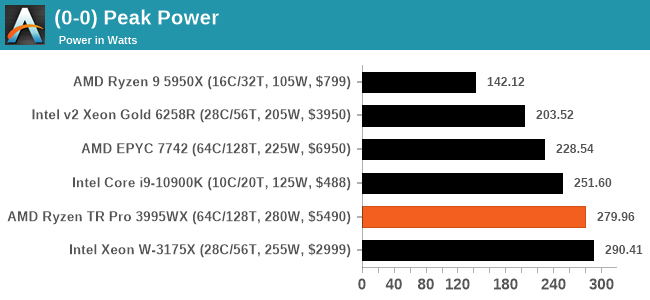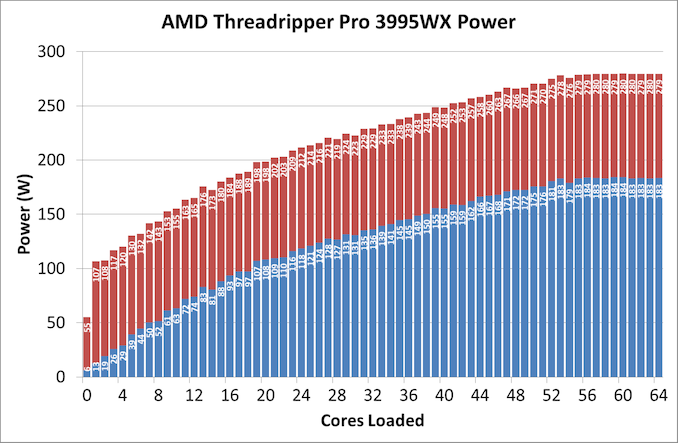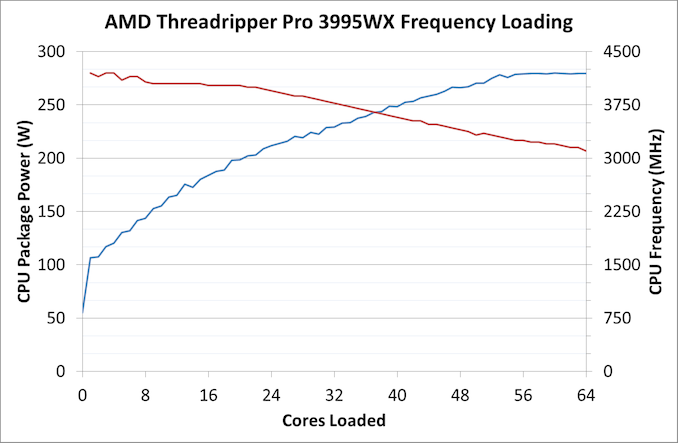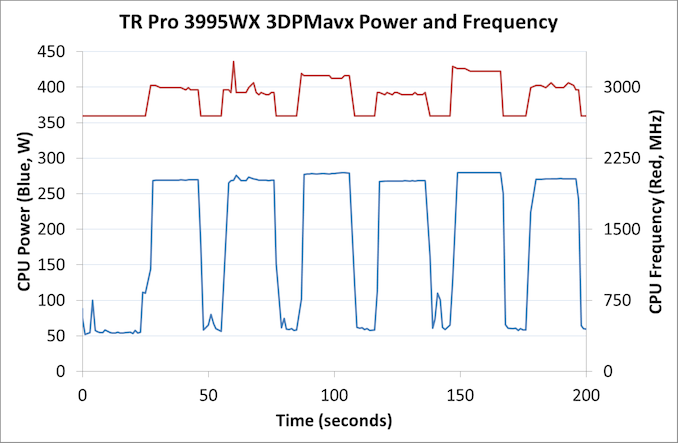64 Cores of Rendering Madness: The AMD Threadripper Pro 3995WX Review
by Dr. Ian Cutress on February 9, 2021 9:00 AM EST- Posted in
- CPUs
- AMD
- Lenovo
- ThinkStation
- Threadripper Pro
- WRX80
- 3995WX
Power Consumption
The nature of reporting processor power consumption has become, in part, a dystopian nightmare. Historically the peak power consumption of a processor, as purchased, is given by its Thermal Design Power (TDP, or PL1). For many markets, such as embedded processors, that value of TDP still signifies the peak power consumption. For the processors we test at AnandTech, either desktop, notebook, or enterprise, this is not always the case.
Modern high performance processors implement a feature called Turbo. This allows, usually for a limited time, a processor to go beyond its rated frequency. Exactly how far the processor goes depends on a few factors, such as the Turbo Power Limit (PL2), whether the peak frequency is hard coded, the thermals, and the power delivery. Turbo can sometimes be very aggressive, allowing power values 2.5x above the rated TDP.
AMD and Intel have different definitions for TDP, but are broadly speaking applied the same. The difference comes to turbo modes, turbo limits, turbo budgets, and how the processors manage that power balance. These topics are 10000-12000 word articles in their own right, and we’ve got a few articles worth reading on the topic.
- Why Intel Processors Draw More Power Than Expected: TDP and Turbo Explained
- Talking TDP, Turbo and Overclocking: An Interview with Intel Fellow Guy Therien
- Reaching for Turbo: Aligning Perception with AMD’s Frequency Metrics
- Intel’s TDP Shenanigans Hurts Everyone
In simple terms, processor manufacturers only ever guarantee two values which are tied together - when all cores are running at base frequency, the processor should be running at or below the TDP rating. All turbo modes and power modes above that are not covered by warranty. Intel kind of screwed this up with the Tiger Lake launch in September 2020, by refusing to define a TDP rating for its new processors, instead going for a range. Obfuscation like this is a frustrating endeavor for press and end-users alike.
However, for our tests in this review, we measure the power consumption of the processor in a variety of different scenarios. These include full AVX2/AVX512 (delete as applicable) workflows, real-world image-model construction, and others as appropriate. These tests are done as comparative models. We also note the peak power recorded in any of our tests.
AMD Ryzen Threadripper Pro 3995WX
The specifications for this processor list 64 cores running at a TDP of 280 W. In our testing, we never saw any power consumption over 280 W:

Going through our POV-Ray scaling power test for per-core consumption, we’re seeing a trend whereby 40% of the power goes to the non-core operation of the system, which is also likely to include the L3 cache.

Red = Full Package, Blue = CPU Core only (minus L3 we think)
We only hit the peak 280 W when we are at 56-core loading, otherwise it is a steady climb moving from 7 W/core in the early loading down to about 3 W/core when fully loaded. What this does for core frequencies is relatively interesting.
Our system starts around 4200 MHz, which is the rated turbo frequency, settling down to 4000-4050 MHz in that 8-core to 20-core loading. After 20 cores, it’s a slow decline at a rate of 25 MHz per extra core loaded, until at full CPU load we observe 3100 MHz on all cores. This is above the 2700 MHz base frequency, but also comes out to 2.86 W per core in CPU-only power, or 4.37 W per core if we also include non-CPU power. Note that non-CPU power in this case might also include the L3.
For an actual workload, our 3DPMavx test is a bit more aggressive than POV-Ray, cycling to full load for ten seconds for each of its six algorithms then idling for a short time. In this test we saw idle frequencies of 2700 MHz, but all-core loading was at least 2900 MHz up to 3200 MHz. Power again was very much limited to 280 W.












118 Comments
View All Comments
Fellovv - Tuesday, February 9, 2021 - link
Agreed— picked up a p620 with 16c for $2500, could have gotten it for lower from Lenovo if they didn’t have weeks of lead time. Ian- you may see Lenovo discounts all the crazy prices about 50% all year, and sometimes there are Honey coupons to knock off hundreds more.I have read that the 16c 2 CCX 3955WX May only get 4 channel RAM, not the full 8. I may be able to confirm in the near future. Gracias for the fine and thorough review. My only request is to ensure the TR 3990 is included in every graph— it was MIA or AWOL in several. I went with they TR Pro for the RAM and PCIe 4 lanes. Seeing the results confirms it was a good choice for me. Can’t wait for the Zen3!
realbabilu - Tuesday, February 9, 2021 - link
Nice 👍 about mkl, how about blis and open las,.did it suffer high multi core problemMonkeyMan73 - Wednesday, February 10, 2021 - link
AMD has the performance crown in most scenarios, but it comes at an extremely high price point. Might not be worth this kind of money even for most extreme power user. Maybe get a dual core Xeon? Might be cheaper.BTW, your las pic of this review is definitly not an OPPO Reno 2 :)
MonkeyMan73 - Wednesday, February 10, 2021 - link
Apologies, not a Dual core Xeon, that will not cut it but meant a Dual Socket Xeon setup.Oxford Guy - Wednesday, February 10, 2021 - link
The worst aspect of the price-to-performance is that it’s using outdated tech rather than Zen 3.MonkeyMan73 - Sunday, February 28, 2021 - link
Correct, there is always some sort of trade-off.Greg13 - Wednesday, February 10, 2021 - link
I feel like you guys really need to get some more memory intensive workloads to test. So often in these Threadripper / Threadripper Pro / EPYC reviews, the consumer CPU (5950X in this case) is often faster or not far behind even on highly multithreaded applications. I do some pretty large thermal fluid system simulations in Simscape where by once a system is designed I use an optimisation algorithm to find the optimal operating parameters of the system. This involves running multiple simulations of the same model in parallel using Matlab Parallel computing toolbox along with their global optimisation toolbox. Last year I bought a 3950X and 128GB ram to do this, but as far as I can tell it is massivly memory bandwidth limited. It's also memory capacity limited too... Each simulation uses around 10GB ram each, so I generally only run 12 parallel workers to keep within the 128GB of ram. However, In terms of throughput I see barely any change when dropping down to 8 parallel workers, suggesting, I think that with 12 workers, it's massivly memory bandwidth limited. This also seems to be the case in terms of the CPU power, even with 12 workers going, the CPU power reported is pretty low, which leads me to think it's waiting for data from memory?I assume that this would be better with Threadripper or even better with Threadripper Pro with their double and quadrouple memory bandwidth. However I don't have the funds to buy a selection of kit and test it to see if the extra cost is worth it. It would be good if you guys could add some more memory intensive tests to the suite (ideally for me some parallel Simscape simulations!) to show the benefit these extra memory channels (and capacity) offer.
Shmee - Wednesday, February 10, 2021 - link
Yeah I would wait for Zen 3 TR for sure. That said, this would only make sense as X570 has limited IO. It would be great to have a nice 16 core TR that had great OC capability and ST performance, was great in games, and did not have the IO limitation as X570. I really don't need all the cores, mainly I care about gaming, but the current gaming platforms just don't have the SATA and m.2 ports I would like. Extra memory bandwidth is also nice.eastcoast_pete - Wednesday, February 10, 2021 - link
Thanks Ian! I really wanted one, until I saw the system price (: But, for what these proTRs can do, a price many are willing and able to pay.Also, as it almost always comes up in discussions of AMD vs Intel workstation processors: could you write a backgrounder on what AVX is/is used for, and how open or open source extensions like AVX512 really are? My understanding is that much of this is proprietary to Intel, but are those AVX512 extensions available to AMD, or do they have to engineer around it?
kgardas - Wednesday, February 10, 2021 - link
avx512 is instruction set implemented and invented by Intel. Currently available in TigerLake laptops and Xeon W desktops plus of course server Xeons. Previous generation was AVX2 and generation before AVX. AVX comes with Intel's SandyBridge cores 9 years ago IIRC. AVX2 with Haswell.Due to various reasons IIRC AMD and Intel cross-licensed their instruction sets years ago. Intel needed AMD's AMD64 to compete. Not sure if the part of the deal is also future extensions, but I would guess so since AMD since that time implemented both AVX and AVX2. Currently AMD sees no big pressure from Intel hence I guess is not enough motivated to implement avx512. Once it is, I guess we will see AMD chips with avx512 too.